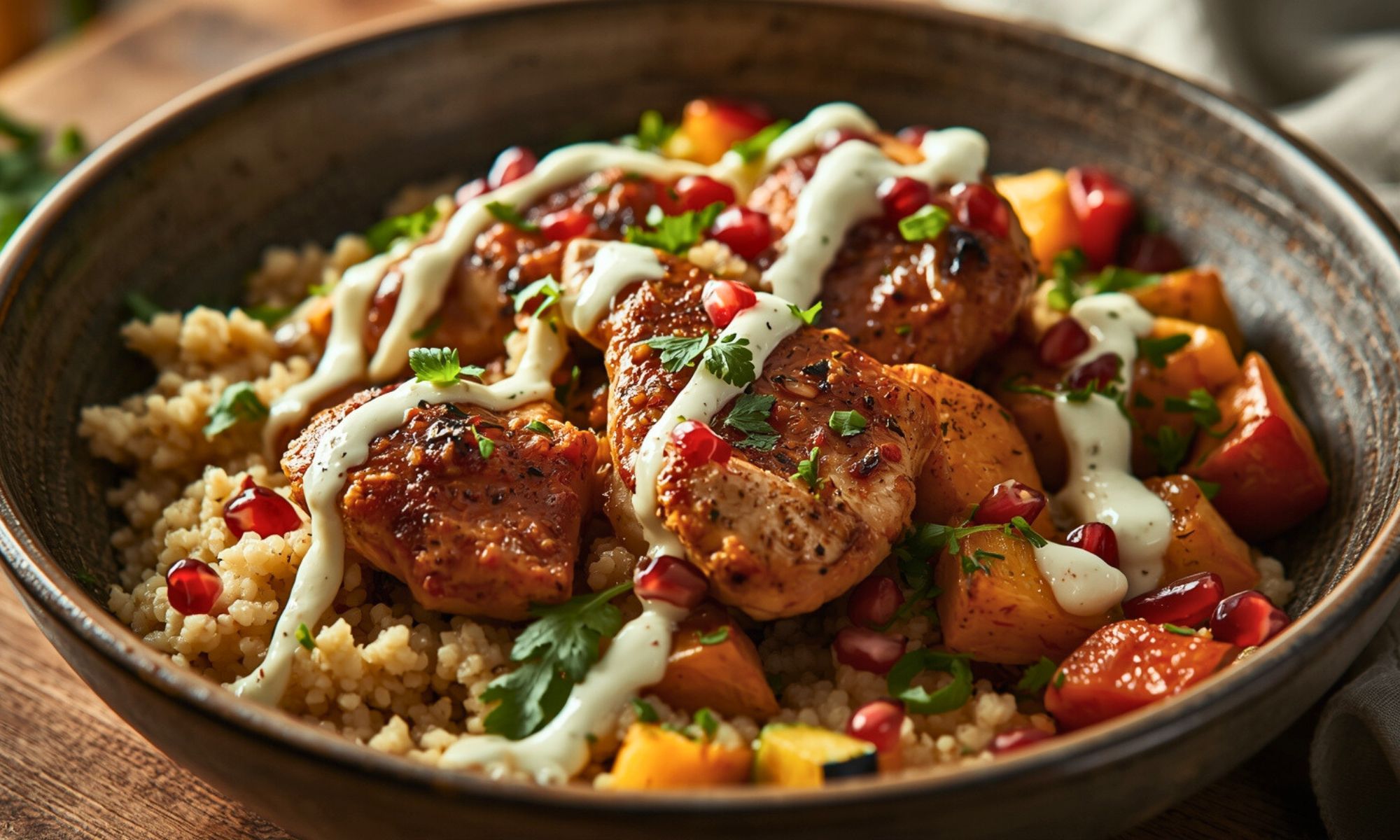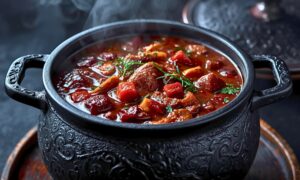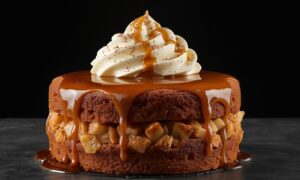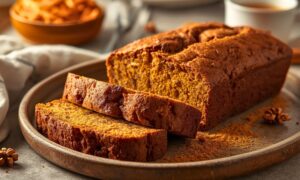After a long day, all I wanted was comfort on a plate. That’s when harissa paste turned simple chicken into Harissa Chicken Bowls, warm, flavorful, and exactly what I needed. In just thirty minutes, I went from exhausted to completely satisfied, with a bowl that tasted like hours of cooking but took almost no effort.
Craving something bold, something that wakes up your taste buds after draining days? These bowls deliver exactly that punch. The North African spice paste transforms ordinary chicken into something spectacular, smoky, slightly spicy, with depth that keeps you coming back.
This isn’t just another chicken and rice situation. We’re building layers here: crispy edged chicken with a caramelized harissa coating, fresh crunchy vegetables for brightness, creamy elements to cool the heat, and grains that soak up every gorgeous drop. It’s balanced, satisfying, and honestly addictive.
The beauty lies in flexibility too. Got twenty minutes? You can pull this off. Have an hour to cook leisurely? Even better, the flavors deepen. Prepping for the week ahead? These bowls keep beautifully for days.
Harissa paste truly does the heavy lifting here. This North African wonder brings complexity without requiring seventeen ingredients, making it the heart of these flavor packed bowls.
Why These Harissa Chicken Bowls Transform Dinner
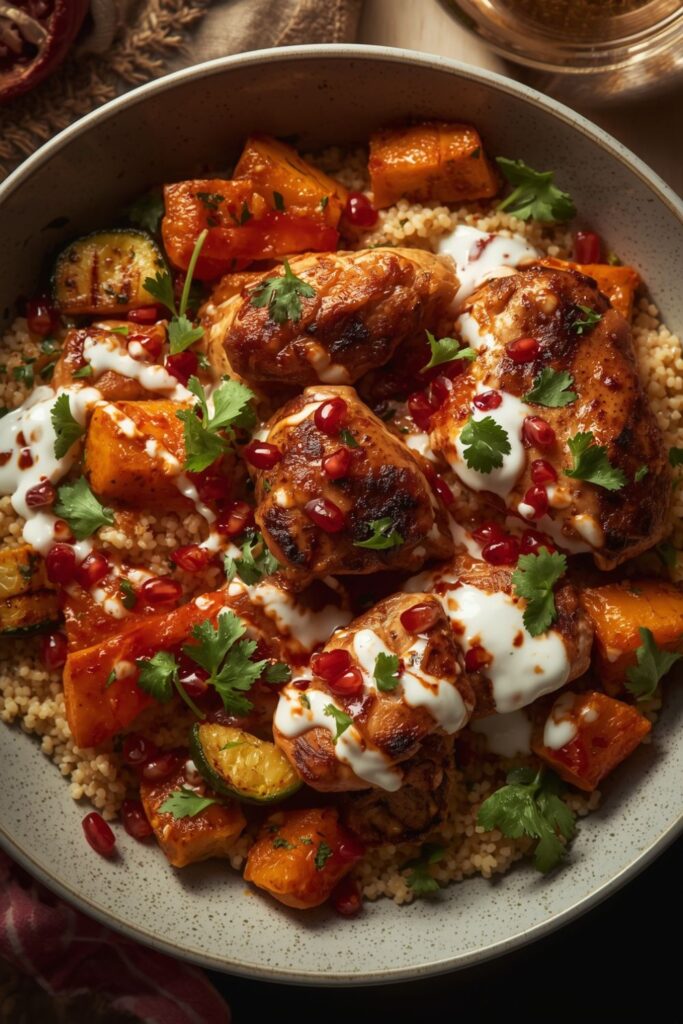
Let me paint you a picture. You’re rushing home from work. Maybe you hit the gym first. Or picked up kids from practice. The last thing you want is complicated cooking. But you refuse to settle for boring food. That’s exactly where these bowls shine brightest.
Traditional bowl recipes often fall flat. Either they’re bland and “healthy” tasting. Or they’re loaded with heavy sauce. These walk that perfect line. They’re vibrant, satisfying, and genuinely crave worthy. Your family won’t realize they’re eating vegetables.
The technique here is dead simple. You’re making spiced chicken and assembling components. No fancy knife skills required. No complicated sauces that might break. Just straightforward cooking yielding restaurant quality results.
What really sets these bowls apart is adaptability. Vegetarian friend coming over? Swap chickpeas for chicken. Following low carb? Skip grains, double the veggies. Got picky eaters? They customize their own bowls. Everyone gets exactly what they want.
Essential Ingredients for Perfect Harissa Chicken Bowls
Ingredients That Make It Magic
Chicken thighs – 1½ pounds, boneless and skinless. Thighs stay juicier than breasts. They handle high heat without drying out.
Harissa paste – 3-4 tablespoons. This is your flavor foundation. Don’t skip it.
Olive oil – 3 tablespoons, divided. Good quality makes a difference here.
Garlic – 4 cloves, minced. Fresh only, please.
Lemon – 2 lemons (juice and zest). Brightness is key here.
Greek yogurt – 1 cup, full-fat preferred. Creates the cooling sauce that balances heat.
Building Your Bowl Base
Grains – 2 cups cooked (quinoa, rice, or couscous). Pick your adventure.
Cucumbers – 2 medium, diced. Adds refreshing crunch.
Cherry tomatoes – 2 cups, halved. Bursts of sweetness throughout.
Red onion – ½ medium, thinly sliced. Soak in cold water first.
Fresh herbs – 1 cup mixed (cilantro, parsley, mint). Fresh herbs are non negotiable.
Chickpeas – 1 can, drained and rinsed. Optional but highly recommended.
The Finishing Touches
Tahini – ¼ cup for drizzling. Adds nutty richness.
Honey – 1 tablespoon. Balances the heat in yogurt sauce.
Cumin – 1 teaspoon. Earthy warmth that complements harissa perfectly.
Smoked paprika – ½ teaspoon. Deepens that smoky profile.
Salt and black pepper – to taste. Season boldly.
Smart Swaps That Actually Work
Can’t find harissa paste at your store? Make a quick version. Blend roasted red peppers with chili flakes, garlic, cumin, and caraway. Add olive oil until it’s paste like. Not identical, but it’ll get you close.
Dairy free? Use coconut yogurt instead. Choose unsweetened, plain varieties. The cooling effect works just the same.
Grain free folks, cauliflower rice is your friend here. Or try roasted sweet potato chunks. Both soak up the dressing beautifully.
Don’t have tahini? Almond butter works in a pinch. Thin it with lemon juice and water. You’ll get similar creaminess.
Fresh herbs too pricey? I get it. Use what you can afford. Even just cilantro alone works. But try to include at least one herb. It really does transform the dish.
Chicken thighs sold out? Okay, breasts can work. Pound them thin first. Cook at slightly lower heat. Watch them like a hawk so they don’t dry out..
Picking the Best Ingredients
When shopping for harissa, read the label carefully. You want peppers and spices listed first. Brands like Mina or Dea make excellent versions.
For chicken, look for organic when possible. But honestly, cooking method matters more than source.
Your herbs should smell fragrant and look perky. Wilted herbs mean wasted money and zero flavor.
Building Your Harissa Chicken Bowls Step by Step
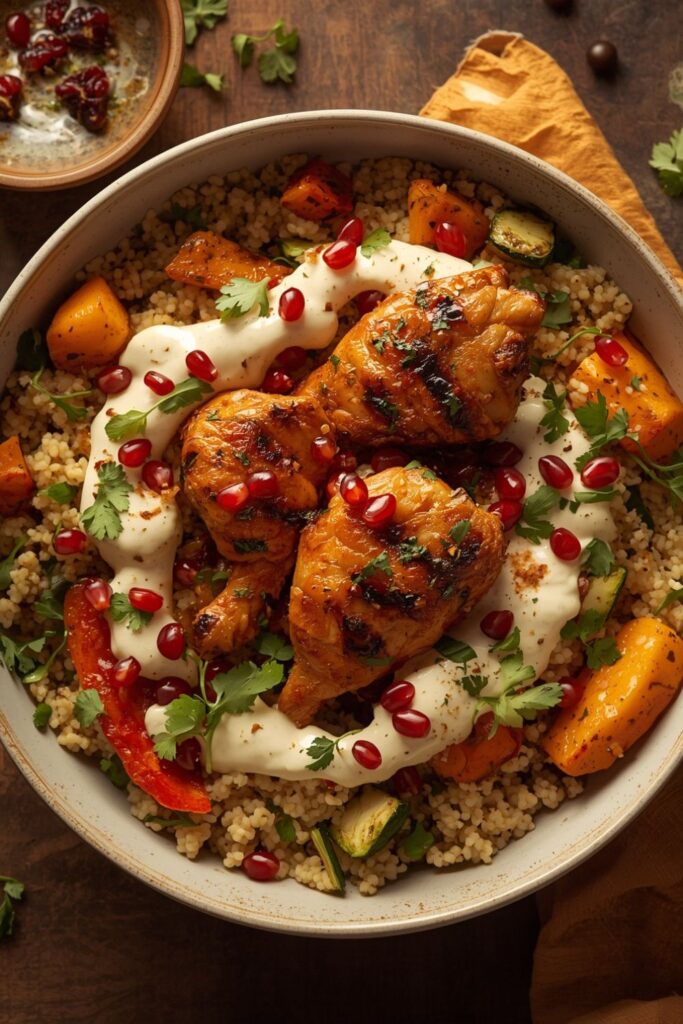
Prep Work Makes Everything Easier
Start by getting everything ready before cooking. Dice your vegetables. Mince your garlic. Measure out your spices. When you’re actually cooking, things move fast.
Cook your grains according to package directions. I usually do this first. While they’re cooking, I prep everything else.
Make your yogurt sauce next. Whisk together Greek yogurt, lemon juice, garlic, and honey. Add a pinch of salt. Stick it in the fridge.
Pat your chicken completely dry with paper towels. This step matters more than you think. Wet chicken won’t caramelize properly.
The Chicken: Where Magic Happens
Cut your chicken thighs into bite sized pieces. About 1½-inch chunks work perfectly.
In a bowl, toss chicken with harissa paste. Really massage it in there. Add a tablespoon of olive oil. Sprinkle with cumin and smoked paprika.
Heat a large skillet over medium high heat. Cast iron works beautifully here. Add another tablespoon of olive oil.
Add your chicken in a single layer. Don’t crowd the pan. Overcrowding makes chicken steam instead of sear.
Here’s the hardest part: leave it alone. Don’t move it around. Let it develop those caramelized edges. About 4-5 minutes on the first side.
Flip each piece. Cook another 3-4 minutes. Golden, slightly charred edges mean flavor heaven.
Remove chicken to a plate. Squeeze half a lemon over it while hot.
The Assembly Line
Time to build your masterpiece. This part’s fun. You’re basically creating edible art.
Start with your grain base. Warm is ideal. Room temperature works too. Divide between four bowls. Create a bed for everything else.
Arrange your chicken on top. Don’t just dump it. Place it thoughtfully. We eat with our eyes first, remember?
Add your fresh vegetables around the chicken. Cucumbers on one side. Tomatoes on another. Keep things colorful and organized. It looks more appealing than everything mixed together.
Scatter your sliced red onion on top. Remember to soak it first in cold water. About 10 minutes. This removes that harsh, raw onion bite. Pat it dry before adding.
If you’re using chickpeas, warm them slightly. Toss with olive oil, salt, and a tiny pinch of cumin. They’re better warm than cold. Scatter them throughout the bowl.
Drizzle your yogurt sauce generously. Don’t be stingy. This brings everything together. It’s the bridge between spicy chicken and fresh vegetables.
Thin your tahini with water until it’s drizzleable. Add lemon juice and a pinch of salt. Drizzle in pretty patterns over everything. Instagram worthy optional, but why not?
Final Flourishes
Tear your fresh herbs and scatter them everywhere. This is not the time for restraint. Herbs add brightness and freshness that balances the rich, spicy chicken. They’re essential, not optional.
Add a final squeeze of lemon over the entire bowl. Cut your lemon into wedges and serve extra on the side. People can adjust brightness to their preference.
Crack some fresh black pepper over everything. The spice complements harissa beautifully. It adds another layer of complexity.
Want extra heat? Drizzle more harissa paste on top. Or serve it on the side. Everyone’s heat tolerance is different. Let people customize.
Common Mistakes to Dodge
Don’t use chicken breasts without adjusting cooking time. They dry out faster than thighs. If you must use breasts, cut them thinner. Reduce cooking time by a couple minutes.
Skipping the yogurt sauce is a mistake. It’s not just about cooling the heat. It adds creaminess and ties flavors together. Without it, bowls taste disjointed.
Using old, dusty harissa paste won’t deliver. Check the date. Spices lose potency over time. Your dish will taste flat instead of vibrant.
Forgetting to salt your vegetables is another rookie move. Season each component separately. Salt brings out natural flavors. Under seasoned vegetables taste like an afterthought.
Don’t assemble bowls too far in advance. The chicken’s fine made ahead. But don’t add fresh ingredients until serving. Herbs wilt. Cucumbers get soggy. Nobody wants that texture situation.
Make It Your Own Variations
Feeling adventurous? Try lamb instead of chicken. The gaminess pairs beautifully with harissa. Cook it the same way. Maybe add some dried apricots for sweetness.
Want it vegetarian? Roast cauliflower florets with harissa. They caramelize gorgeously. Add extra chickpeas for protein. You won’t miss the meat.
Going low carb? Skip grains entirely. Use mixed salad greens as your base. Add more vegetables. Increase the protein portion. Still completely satisfying.
Mediterranean twist? Add kalamata olives and crumbled feta. Use oregano instead of cilantro. Drizzle with red wine vinegar. Suddenly it’s a different dish.
Make it spicy sweet? Add dried cranberries or golden raisins. The sweetness plays beautifully against harissa heat. Throw in some toasted almonds for crunch.
Breakfast version? Top with a fried egg. The runny yolk becomes another sauce. It’s ridiculously good. Trust me on this weird one..
The Science Behind Your Success
Understanding why things work makes you better at cooking. Let’s talk about what’s actually happening here.
Harissa paste contains capsaicin, that’s what creates heat. But it also has complex flavor compounds. When you cook it, these become even more concentrated.
Marinating chicken in harissa does two things. First, acid tenderizes proteins slightly. Second, fat soluble flavors penetrate the meat.
When you sear chicken without moving it, you’re creating crust. This happens through caramelization and Maillard reactions. Both require high heat and dry surfaces.
Greek yogurt’s cooling effect isn’t just psychological. Casein proteins bind with capsaicin molecules. They literally pull heat away from taste receptors.
The acidity in lemon serves multiple purposes. It brightens flavors. It balances richness from fats. And it prevents bacterial growth.
Fresh herbs contain volatile oils that dissipate quickly. Adding them at the end preserves delicate flavors.
Traditional Roots Meet Modern Life
Harissa originated in Tunisia centuries ago. It was a way to preserve peppers. The paste kept well without refrigeration.
Bowl style eating isn’t traditional in North Africa. But it’s perfect for modern lifestyles. Everything in one vessel. Easy to prep ahead. Customizable for different preferences.
The beauty here is cultural fusion at work. North African spices meet Middle Eastern tahini. Mediterranean vegetables join the party. Asian inspired bowl assembly brings it together.
Making It Beautiful & Delicious
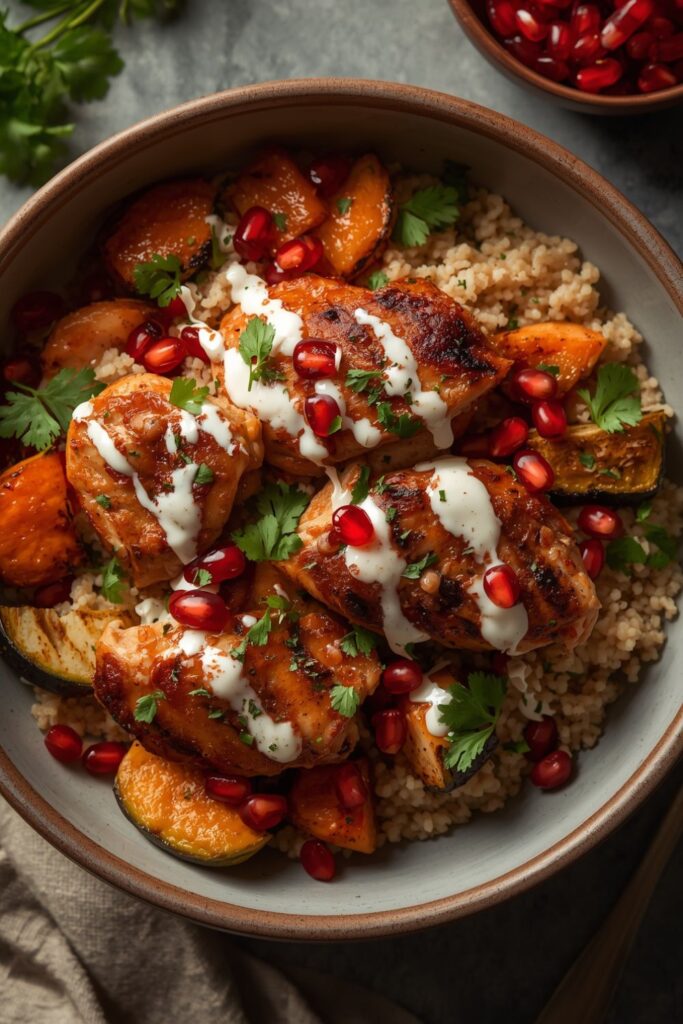
Let’s be real. Food that looks good tastes better. We eat with our eyes first.
Arrange ingredients in sections rather than mixing. This creates visual interest. Different colors in different areas.
Height adds drama to your presentation. Stack that chicken proudly. Let herbs cascade over sides.
Odd numbers look better than even numbers. Place three tomato halves together. Five chickpeas clustered. Our eyes prefer odd arrangements.
Don’t overcrowd your bowl. Let some grain base show through. Give elements room to breathe.
Perfect Pairings
These bowls pair beautifully with crisp white wine. Sauvignon Blanc cuts through the richness. Rosé works year round.
Side wise, keep things simple. Maybe some warm pita for scooping. The bowl is already substantial.
For dessert, go light and fruity. Orange slices with cinnamon. Fresh berries with yogurt.
Mint tea makes an excellent beverage pairing. It’s traditional in North African cuisine.
Bringing It All Home
These Harissa Chicken Bowls deserve a permanent rotation spot. They’re that perfect intersection of quick, healthy, and exciting.
The versatility alone makes them valuable. Monday’s dinner becomes Tuesday’s lunch. Swap proteins, grains, and vegetables based on what’s available.
What really makes these bowls special is feeling. Accomplished because you cooked something impressive. Satisfied because flavors are complex and interesting.
You’re building confidence with every bowl made. Learning to layer flavors. Understanding how spice and cooling balance. These skills transfer to countless dishes.
Start with this recipe exactly as written. Get comfortable with the process. Then begin experimenting. Make it yours.
Keep that harissa paste stocked. It’s your secret weapon for transforming ordinary ingredients.
Most importantly, don’t stress about perfection. Cooking should be joyful, not stressful.
Frequently Asked Questions
Can I make Harissa Chicken Bowls ahead for meal prep?
Absolutely, these bowls are meal prep champions. Cook your chicken and grains on Sunday. Store them separately in airtight containers. Prep vegetables but keep them separate too. Don’t assemble until you’re ready to eat. Chicken stays good for 3-4 days refrigerated. Grains last about 5 days. Keep fresh herbs in damp paper towels. Assemble individual portions as needed. Yogurt sauce keeps for a week.
What if I can’t handle spicy food?
You can totally adjust the heat level. Start with just one tablespoon of harissa. You’ll get flavor without overwhelming heat. The yogurt sauce also helps tremendously. Use extra yogurt if needed. You can also mix harissa with tomato paste. This dilutes spice while maintaining flavor. Fresh herbs and lemon both help balance heat. Adjust it to your comfort level.
Can I use chicken breasts instead of thighs?
Yes, but you’ll need to adjust technique. Chicken breasts dry out faster. Cut them into thinner pieces. Reduce cooking time to 3-4 minutes per side. Watch them carefully. Consider brining them for 30 minutes before cooking. A meat thermometer is your friend here.
How do I store and reheat leftovers properly?
Keep components separated if possible. Store chicken in one container. Grains in another. Fresh vegetables stay separate too. Refrigerate within two hours of cooking. Everything keeps for 3-4 days safely. Reheat chicken and grains separately. Don’t reheat fresh vegetables. Add fresh yogurt sauce after reheating.
What’s the best substitute if I can’t find harissa paste?
Make a quick version at home. Blend roasted red peppers with garlic. Add cumin, caraway, coriander, and tomato paste. Include chili flakes to taste. Blend smooth, adding olive oil. Alternatively, try Turkish chili paste. Or use smoked paprika with cayenne pepper.

Swiftly Captions by Tina Smith — Quick, flavorful food recipes made simple, bringing fresh inspiration to your kitchen every day
